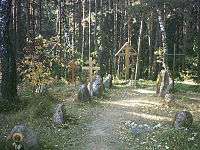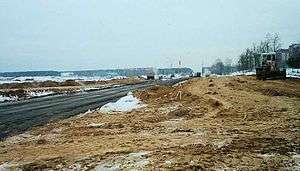Kurapaty
Kurapaty (Belarusian: Курапаты, IPA: [kuraˈpatɨ]) is a wooded area on the outskirts of Minsk, Belarus, in which a vast number of people were executed between 1937 and 1941 during the Great Purge by the Soviet secret police, the NKVD.

The exact count of victims is uncertain, as NKVD archives are classified in Belarus.[1] According to various sources the number of people who perished in Kurapaty is estimated in at least 30,000 people (according to attorney general of BSSR Tarnaŭski), up to 100,000 people (according to “Belarus” reference book),[1][2] from 102,000 to 250,000 people (according to the article by Zianon Pazniak in “Litaratura i mastactva” newspaper),[3][4] 250,000 people (according to Polish historian and professor of University of Wrocław Zdzisław Julian Winnicki),[5] and more (according to the British historian Norman Davies).[6]
In 2004 Kurapaty mass graves were included in the register of the Cultural Properties of Belarus as a first-category cultural heritage.[7]
Discovery and remembrance

The discovery by historian Zyanon Paznyak and exhumation of the remains in 1988 gave an added momentum to the pro-democracy and pro-independence movement in Belarus in the last years of the Soviet Union before it dissolved. There have been investigations by both the Soviet, and Belarusian governments, which have been conclusive as to the perpetrators who are the Soviet NKVD. This is based on former NKVD members confession and the eyewitness testimonies of 55 villagers, from villages such as Cna, Cna-Yodkava, Drazdova, Padbaloccie and others, that gave evidence that NKVD brought people in trucks and executed them during 1937 – 1941.
President of the United States Bill Clinton visited Kurapaty forest in 1994, when he came to Belarus with a "thank you" visit after Belarus agreed to transfer their post-Soviet nuclear weapons to Russia. Clinton presented a small granite monument "To Belarusians from the American people", perhaps the first post-Soviet cultural artifact from the U.S. on the Belarusian soil. The monument was damaged three times by unidentified vandals, but subsequently restored.
In 2001, when the Kurapaty site was threatened by a planned widening of the Minsk Ring Road, youth from the Belarusian Popular Front, Zubr and smaller organizations occupied the site and sat out a bitter winter in tents, trying to halt the road construction, with no success.
On October 29, 2004, the Jewish community of Belarus installed a monument in memory of the Jews and other nationals who were murdered in Kurapaty forest. The brown granite stone has two inscriptions in Yiddish and in Belarusian: "To our fellow-believers—Jews, Christians and the Muslims—the victims of Stalinism from the Belarusian Jews."
Each year in November, on Dziady (the All Saints or the day when Belarusians commemorate their deceased forefathers), hundreds of people visit this site of crimes of Soviet political repression.
Gallery
 Kurapaty 1989 (Kalinowski street)
Kurapaty 1989 (Kalinowski street) Kurapaty, 1989
Kurapaty, 1989 Minsk ring road under construction through the Kurapaty massacre site (2001)
Minsk ring road under construction through the Kurapaty massacre site (2001)- Protesters' tent (2001)
- Police watch over protesters (2001)
- Crosses and 1989 memorial stone at center of site (2001)
- Close-up of memorial stone (2001)
- Remnant of a memorial placed by US President Bill Clinton, later destroyed (2001)
See also
- Bykivnia
- Dem'ianiv Laz
- Great Purge
- Katyn massacre
- NKVD massacres of prisoners
- Vinnytsia massacre
Bibliography
- Kuropaty: The Investigation of a Stalinist Historical Controversy by David R. Marples - Slavic Review Vol. 53, No. 2 (Summer, 1994), pp. 513–523
- 'Kurapaty The Road of Death' ISBN 5-85700-149-8
External links
References
- Памяць і забыцьцё Курапатаў // RFE/RL, 28.10.2009
- Даведнік «Беларусь». — Мн.: «Беларуская энцыкляпэдыя», 1995.
- З. Пазьняк, Я. Шмыгалёў, М. Крывальцэвіч, А. Іоў. Курапаты. — Мн.: Тэхналогія, 1994.
- Kurapaty // Zaprudnik, Jan. Historical Dictionary of Belarus. — Lamham. — London: Scarecrow Press, 1998. P. 139.
- Zdzisław J. Winnicki. Szkice kojdanowskie. — Wrocław: Wydawnictwo GAJT, 2005. ISBN 83-88178-26-1. — С. 77—78.
- Norman Davies. Powstanie '44. — Kraków: Wydawnictwo Znak, 2004. ISBN 83-240-0459-9. — С. 195
- Постановлениe Министерства культуры № 15 «О зонах охраны материальной недвижимой историко-культурной ценности «Место уничтожения жертв политических репрессий 30-40-х годов XX века в урочище Куропаты» (2004)/ref Читать полностью: http://naviny.by/rubrics/society/2012/10/25/ic_articles_116_179689/